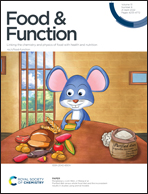Integrated transcriptomics and metabolomics unravel the metabolic pathway variations for barley β-glucan before and after fermentation with L. plantarum DY-1
Abstract
The results of our previous study showed that the structure and function of β-glucan in barley were changed after fermentation by L. plantarum DY-1. In this study, the antioxidant activities of RBG (regular barley β-glucan, unfermented) and FBG (barley β-glucan, fermented with L. plantarum DY-1) were evaluated by adopting an in vivo animal model, Caenorhabditis elegans (C. elegans). We also carried out an integrated transcriptomic and metabolomic profiling for RBG and FBG to delineate their signature pathways. RBG treatment has better effects on SOD enzyme activity and ROS levels than FBG, while FBG treatment has better effects on the CAT enzyme activity and MDA content than RBG in C. elegans. Transcription group analysis showed that FBG mainly decreases the expression of the Cyp-D gene to inhibit the calcium signaling pathway, promotes the Wnt signaling pathway by up-regulating the GSK-3β gene and improving the oxidative damage of C. elegans; RBG mainly inhibits calcium signal pathways by reducing the expression of ANT-solute carrier family 25 genes, promoting life adjustment pathways by reducing the expression of the HSP-12.6 gene to improve the oxidative stress of C. elegans. Joint analysis showed that the difference between FBG and RBG in the regulation of oxidative stress is mainly reflected in the metabolism pathway of arachidonic acid. Under the regulation of FBG, the expression of the C03H5.4 gene was decreased, the expression of leukotriene A4, prostaglandin G2, arachidonic acid and phosphatidylcholine was decreased, and the expression of 14,15-DiHETrE was increased. Under the regulation of RBG, the expression of gene C03H5.4 was up-regulated, the expression of metabolites such as leukotriene B4 was up-regulated, and the expression of arachidonic acid and phosphatidylcholine was down-regulated.



 Please wait while we load your content...
Please wait while we load your content...